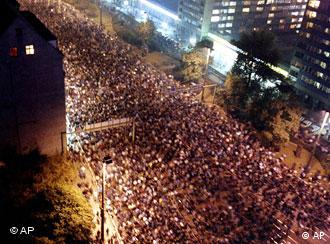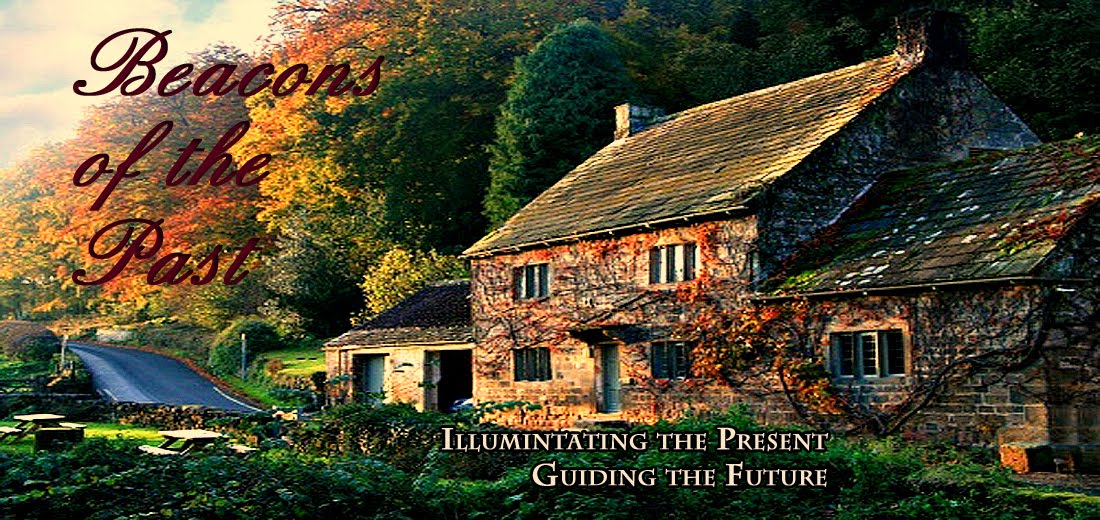 |
| via Wikipedia |
************
On June 12, 1987, President Ronald Reagan delivered a sensational speech in West Berlin in sight of the famous Brandenburg Gate. In it, and in reference to the Berlin Wall that had been a stark symbol of the Cold-War division between East and West since 1961, he dramatically called: 'Mr. Gorbachev, tear down this wall!' In other words, Reagan was calling for an end to the Cold War. That possibility had always seemed very far-fetched with neither the West nor the Soviet Union willing to give in to the other and with nuclear war continually dangling like Damocles' sword over humanity. However, Gorbachev (the new leader of the Soviet Union) also decided it was time to end the Cold War and the mad nuclear arms race. Gorbachev introduced many changes that brought on many unexpected revolutionary events in Eastern European countries which eventually culminated on November 9, 1989, when the Berlin Wall did finally come down. This basically heralded the end of Communist rule in East Germany and the rest of Eastern Europe and two years later, even, the Soviet Union.
 |
| via Google Images |
One of the most extraordinary things about the events that lead to that amazing ending, was the relatively quick and peaceful way in which it was achieved (especially in East Germany). In her book, Candles Behind the Wall: Heroes of the Peaceful Revolution That Shattered Communism, Barbara von der Heydt* relates the event beautifully and compellingly, drawing attention to some very interesting details behind this extraordinary historical event. I thought it best to share it here - in her own words as much as possible:
(Context: By that time, Eastern Germans, with the help of the Lutheran Church who had been praying and calling for peaceful protests, had already started to peacefully protest in the streets against the Communist regime. They were hoping for an end to the oppression they were living under.)
It is clear that during this critical time, Gorbachev withheld explicit approval for a bloodbath to put down the demonstrations, and the East German regime may not have dared to give the order to fire on its own. But this was a radical change for the Soviets, in light of the Soviet response in 1953 in East Germany, in 1957 in Hungary, and in 1968 in Czechoslovakia. And the Soviets had threatened Poland with invasion as recently as 1981. There was nothing inevitable about a peaceful end, as Chinese demonstrators had found out in Tiananmen Square only months before. Had the Soviets themselves changed? Recent behaviour gives no consistent answer: they used violence again in Lithuania in January 1991. But for some reason, the situation in East Germany turned out differently. (emphasis added)
The East German regime was now in disarray. In a tense politburo session on October 18, [1989,] Erich Honecker was unceremoniously dumped and replaced by Egon Krenz. The number of demonstrators swelled to 200,000 in Leipzig, then 300,000. City after city followed Leipzig's example, with millions filling the streets. A nation was on its feet because the people found their voice. The regime was scrambling to meet their pent-up demands to be able to speak freely, to travel, to organize, to reform. So many things were different, including the fresh creativity, wit, courage, and humour that people used to illustrate the banners they carried. It was as if they were negotiating by poster board as their appetite for change was whetted by new victories.
The turning point in Berlin came on November 4, 1989. One million people assembled in the Alexanderplatz, with the "best and brightest" of the country addressing the huge crowd. The mass of people moved in procession to Unter den Linden, then to the Palace of the Republic, then back to the Alexanderplatz. The critical point came at the Palace of the Republic, where the street continues straight on to the Brandenburg Gate, the huge, well-known archway that is the gateway between East and West Berlin, and symbolically between the two parts of the divided country.
 |
| Marchers in Leipzig 1989 via google images |
Anyone who could think militarily knew that if a million people continued marching straight ahead, the tanks would have to roll and the soldiers would have intervene to stop them. But those in the procession also knew the Stasi and their methods. If the Stasi put a few hundred provocateurs into the crowd to keep marching ahead, to draw the crowd toward the Brandenburg Gate, that would provide the needed reason to attack. It was not discussed, but all the genuine participants knew that even if hundreds broke away they must not.
Von der Hydt then relates the impressions of one of those who were participants in that demonstration....
What he remembers most is the silence: "Hundreds and thousands of people walked around this curve without saying a word. It was a silent march at this point. One heard only the soft sound of the feet of these people. Everyone knew this was the critical point." There was no provocation, there was no attack. A million people silently signaled with their feet they wanted change, but peaceful change.
Five days later, the Berlin Wall fell...
 |
| via Pinterest |
The news reached the airwaves with lightening speed and people swarmed to the cross-points in Berlin some still in pajamas, mobbing the surprised border guards, who knew nothing about what had happened. When the people told them what they'd heard on the radio, the guards were unsure what to do. After trying to hold back the growing, jostling crowd, some guards in exasperation and confusion simply shoved back their caps and let the people charge through. The crowd became jubilant, and the people of a nation that had been divided fell into each other's arms. There were tears, flowers, and streams of uncorked champagne.
Shortly thereafter, on New-Year's Day, young people danced on the Wall in exhilaration, and the nation wept in disbelief and joy. Reunification, which occurred on October 3, 1990, took place less than a year from the moment the Wall fell.
On the night that the Wall fell, people leaving the Nikolikirche marched through the centre of the city. Week after week during the fall of 1989, they had marched in a circle around Leipzig after the Friedensgebete. On November 9 they marched for the seventh time, commemorating the fifty-first anniversary of Kristallnacht, the beginning of violence against the Jews leading up to World War II. An on that night, people left the Nikolaikirche praying for their country. As they walked through Leipzig for the seventh time, they heard a crash as resounding as that one heard in Jericho: it was the sound of the Berlin Wall falling. The German Democratic Republic had been in existence for exactly forty years.
The biblical allusions are startling. (emphasis added)Christian Fuhrer, an East German pastor, had this to say about what happened - that it was 'a powerful testament to God's Spirit at work on earth':
"Non-violence is clearly the spirit of Jesus. With these people who grew up with pictures of class enemies, and whose parents grew up with the Nazis and violence and racial hatred, you can prove that it didn't come from here. It's not a question of one's upbringing. And the few Christians that there are in this unchristian country - they didn't do it either....That was the spirit of God at work. We [Christians] couldn't have done it....God honoured by letting us play this part in His plan."
(Candles Behind the Wall, pp. 187-189)
Little further comment is needed. The story speaks of itself of God's amazing grace and providence in it all. Not to mention the power of prayer!
Here is a documentary video of those events (a first hand source):
Episode 22: 'Star Wars'
Episode 23: 'The Wall Comes Down'
Episode 14: 'Conclusions'
_____________________________________________________ |
| via Google Images |
_____________________________
Reference:
Von der Hydt, Barbara, Candles Behind the Wall: Heroes of the Peaceful Revolution That Shattered Communism, Grand Rapids, Michigan: William B. Eerdman's Publishing Company, 1993.
